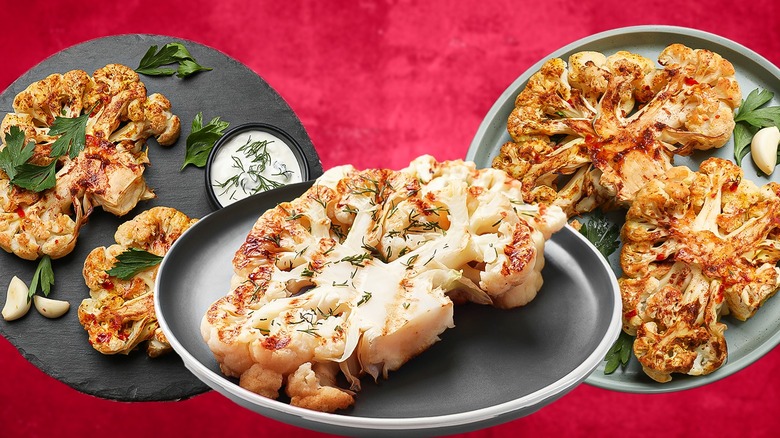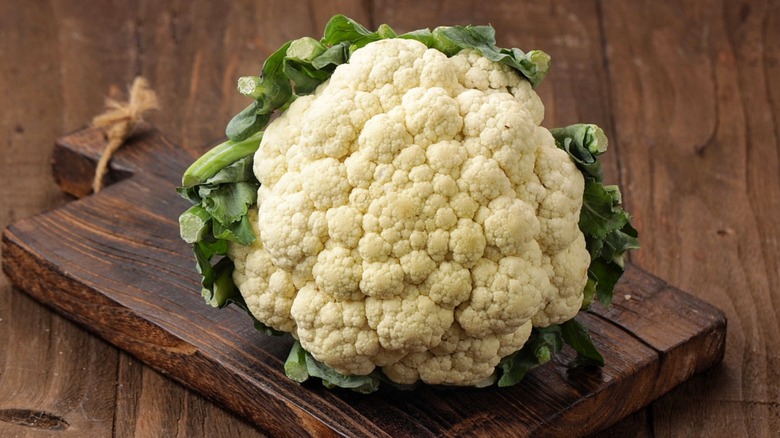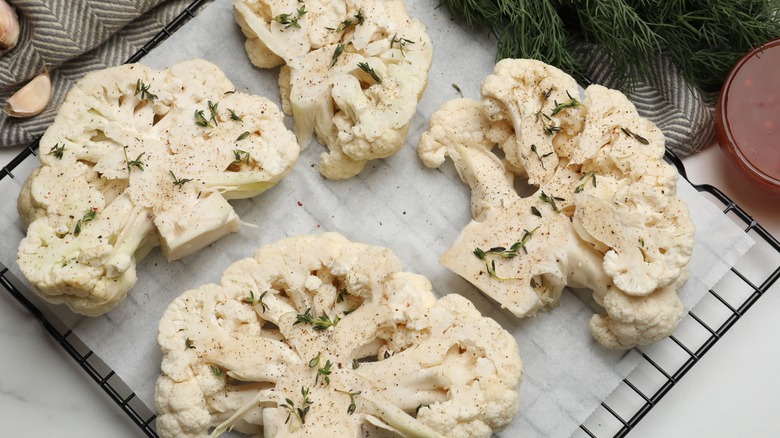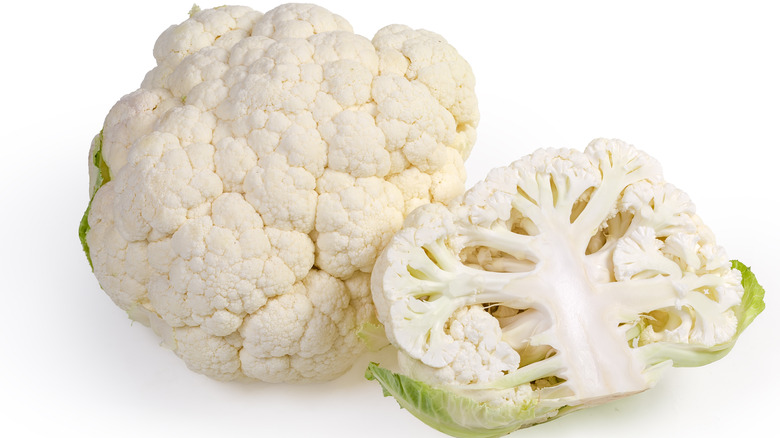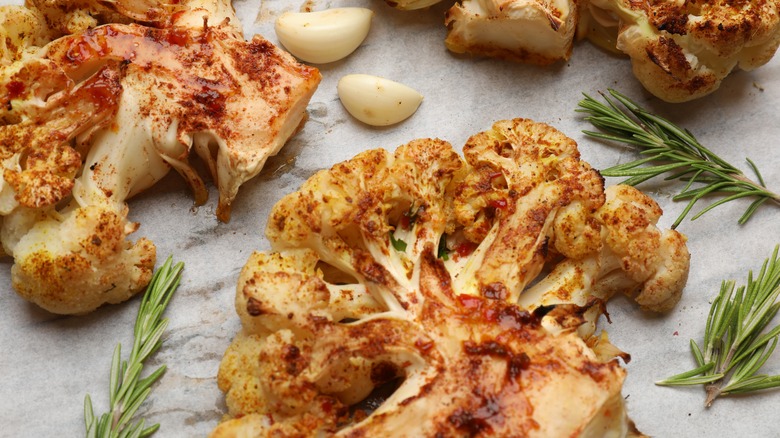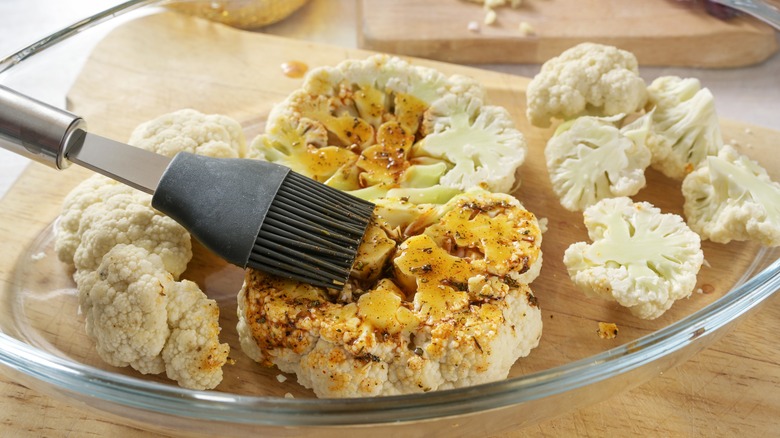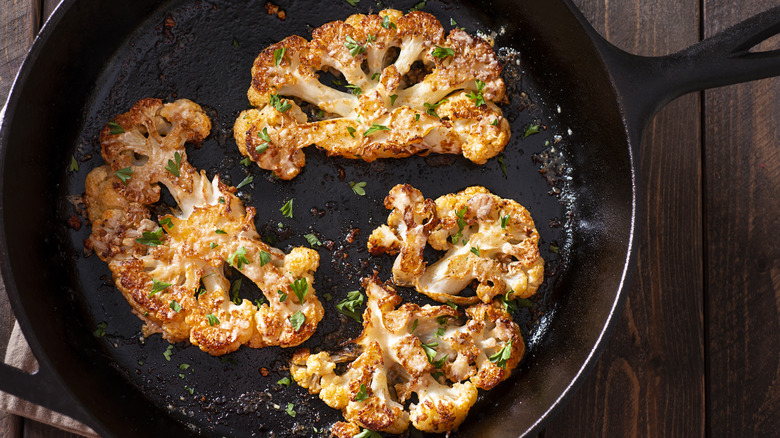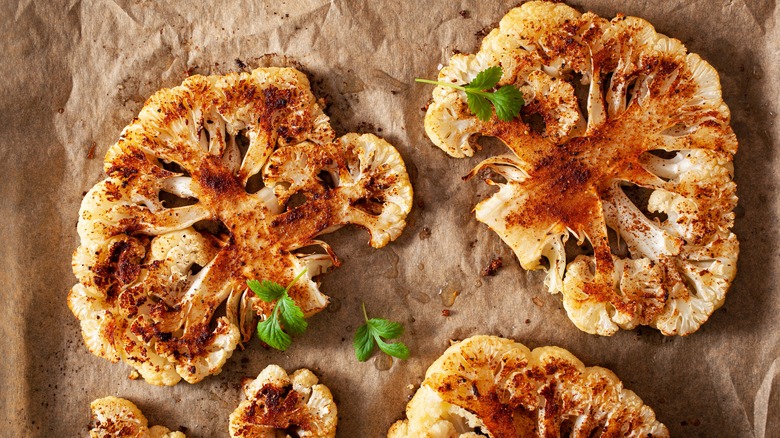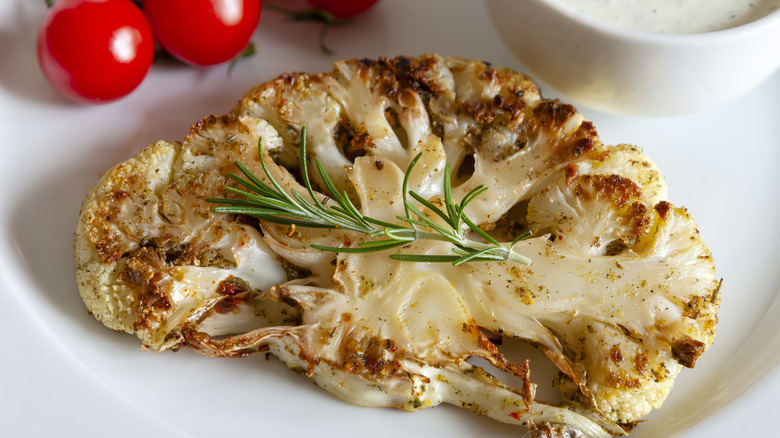9 Mistakes Everyone Makes With Cauliflower Steaks
We require a lot from cauliflower. It's not enough that it's a tasty vegetable in its natural form; we turn it into cauliflower rice, use it to make gluten-free pizza crust, and much more. Vegans jonesing for chicken wings can enjoy cauliflower 'wings' instead, and low-carb lovers get mashed cauliflower in place of mashed potatoes. Even with all of these delicious variations, we're not done with cauliflower yet. Enter cauliflower steaks.
Cauliflower steaks are thick slices cut from a whole head of cauliflower. The slices are cooked whole, creating a 'steak' like a slab of cauliflower instead of being broken or cut into individual florets. They're typically roasted, grilled, or pan-fried to create a flavorful plant-based alternative to a traditional steak. When cooked perfectly, cauliflower steaks develop a crisp, golden brown crust while maintaining their soft, tender center.
I became a cauliflower expert when the low-carb diet phase hit. Many of my personal chef clients started requesting cauliflower as a replacement for rice, potatoes, and more. Cauliflower steaks became a go-to dish for these clients, and I mastered the technique. As simple as it may sound, cooking cauliflower steaks can be tricky, especially if you fall victim to these mistakes everyone makes when cooking them.
Choosing the wrong cauliflower
Not all heads of cauliflower are created equally, especially when it comes to making cauliflower steaks. Selecting the right cauliflower is crucial for making steaks that are sturdy enough to hold up during cooking. These tips will help you tell if your cauliflower has gone bad. Avoid smaller heads of cauliflower. You'll get fewer steaks out of them and they are more likely to break apart easily when cooked.
Instead, look for a large, firm head and pay close attention to the florets. They should be firm and tightly packed. Larger cauliflower will give you more steaks and tighter florets are more likely to remain intact. Skip any that are bruised, starting to brown or those with soft spots. These are all signs that the cauliflower is beginning to spoil.
I make a habit of picking up the cauliflower to gauge its weight before buying it. A ripe, quality cauliflower should feel much heavier than it looks. The fresher the produce is, the more water it contains. This excess water causes it to weigh more than it looks like it should.
Don't forget to check out the leaves. They should be bright green if the cauliflower was harvested recently. Finally, look at the color of the cauliflower. It should be a creamy white with no spots. If you're buying colorful cauliflower — they come in orange, purple, and green — make sure those colors are even across the vegetable, as well.
Slicing them too thick or too thin
Getting the thickness right is key when cooking cauliflower steaks. It's essential for even cooking and for holding their shape. Slice the steaks too thin and you'll likely end up with cauliflower pieces instead of steaks. Thin slices are far more likely to fall apart, especially when they soften as they're cooked. It's also easier to burn thin slices.
On the flip side, cutting your cauliflower steaks too thick can also lead to a disaster in the kitchen. Thick slices are likely to brown or burn on the surface while remaining raw and tough in the center.
I always recommend to my cooking class students that their goal should be to cut food into pieces or slices that are about the same size. This is especially true for cauliflower steaks, because if you're not careful cooking steaks that are significantly different in size can have calamitous results. Cauliflower's round shape means you'll have center slices that are larger than those cut from the rounded sides. Making sure they're all about the same thickness will make it easier to cook them just right.
For best results, make sure all of your cauliflower steaks are between ¾ to 1 inch thick. This is thick enough that they won't crumble when cooked and not so thick that they're impossible to cook evenly.
Removing the stalk
The ultimate goal when making cauliflower steaks is to have a hearty steak that you can cut into. The biggest problem with cauliflower is keeping the florets in place before, during, and after cooking them. One way to ensure your cauliflower steaks stay together is to avoid removing too much of the stalk or core when you slice it.
The stalk that runs through the center of the head of the cauliflower helps hold all of the florets together as it grows. You need to keep the stalk in place with cauliflower steaks. In the same way it provides structure and stability to the whole head, the stalk serves the same purpose when cut into steaks. It's what keeps the steaks together.
You'll notice when you cut your steaks that the slices cut directly from the center of the head of cauliflower will be sturdier than those cut from the sides. This is because the center slices have the benefit of the stalk running through them.
Skipping the seasonings
No matter how well you cook a dish, if it's not seasoned properly, it will likely disappoint. Salt and pepper should be every cook's starting point, but there are a host of herbs, spices, and seasoning blends that can help add big flavor to your food. Some foods, like cauliflower, benefit more than others from a healthy dose of seasonings.
On its own, cauliflower has a naturally mild taste, and skipping the seasonings will leave you with a plate full of blandness. Consider it a blank canvas for the seasonings you add to it. Turn to your spice rack and marinades to give your cauliflower steaks a bold depth of flavor. Start with the basics like garlic powder or onion powder or explore bolder flavors like smoked paprika, Italian seasoning or cumin. Other spices like cardamom and curry powder also work well on cauliflower. You can also make your own spice blends for seasoning.
Another way to add flavor is to marinate your cauliflower steaks. Do this after your steak is cooked since cauliflower absorbs flavors faster after it's cooked.
Using too little or too much oil
Not getting the amount of oil you use to cook your cauliflower steaks right can have a huge negative impact on both the texture and the taste of your finished product. The amount of oil may vary slightly depending on how you cook the steaks, but whether you grill, roast, or pan-fry them, it's crucial that you use the right amount of oil. Too little and your steaks will be dry and will probably stick to your pan, baking sheet, or grill. Too much oil, and you'll have soggy cauliflower that will never crisp. Knowing how much oil you should actually use is key.
Roasting is my favorite way to prepare cauliflower steaks. It gives the vegetable so much flavor, and the texture's just right — a little crisp on the outside with a tender center. In general, you want to use enough oil to give your vegetables a thin coating. They should glisten but should not be sitting in a pool of oil. As a general rule, use about a tablespoon of oil for every pound of vegetables you're cooking, cauliflower steaks included.
To sauté your steaks, add just enough oil to create a thin coat of oil evenly across the bottom of the pan. For grilled cauliflower steaks, brush the steak lightly with oil before adding to the grill. You can also brush your grill with oil for added protection.
Not getting the temperature right
No matter how you choose to cook your cauliflower steaks, it's important that you get the temperature right in order to yield the best results. The goal is cauliflower steaks with a crispy, golden exterior that are tender inside, but if you cook the steaks on heat that's too low, they won't brown properly, and you run the risk of a soft, mushy texture instead.
The caramelized exterior that makes cauliflower steaks so appetizing is created by high heat. However, you have to make sure the temperature is not too high. Cooking them at too high a temperature will cause them to burn on the outside, and the center will likely not be fully cooked. Always preheat your pan, oven, and even your grill before adding your steaks.
To roast cauliflower steaks, your oven should be between 425 F and 450 F. To make your steaks extra crispy, preheat the pan before you place the steaks on them. You'll want to make sure your grill and your sauté pan are on medium heat. This is hot enough to brown them slowly and give the inside time to cook thoroughly.
Cooking them too close together
One easy way to inadvertently ruin cauliflower steaks is to crowd too many of them into your pan or onto your baking sheet. You should always avoid crowding your pans when cooking, but it's especially important with cauliflower. Like many vegetables, cauliflower contains a lot of water. In fact, its water content is 92%. This isn't necessarily a bad thing until you bunch too many steaks into a pan. When they're crowded together without room for air to circulate around each steak, the cauliflower will start to release its water content in the form of steam. The steam will cook the cauliflower, but it will never crisp or brown if steam is present.
Give cauliflower steaks plenty of room to cook, making sure they don't touch and are in one even layer in your pan. You should cook them in batches if your pan isn't large enough to hold them all. If you're roasting them, avoid placing two pans of cauliflower steaks in the oven at the same time. The top pan will act like a lid for the pan on the bottom rack, causing those steaks to steam instead of roast. I learned that lesson the hard way prepping cauliflower steaks for a client's dinner party. If you give them plenty of space, you're more likely to end up with steaks that you'll enjoy eating.
Being rough with the flip
In many of my cooking classes, there were some tasks that were intimidating to people no matter how skilled of a cook they were. Flipping food as it cooked was one of them. Whether it was crepes or chicken breasts or cauliflower steaks, when it came time to flip food I could feel the tension in the kitchen rise. Some people were afraid of burning themselves with any oil that might have splashed out of the pan when they dropped the food back in on the other side. Others were afraid to damage what they were cooking. Either way, the results were usually bad because instead of sliding the spatula underneath and flipping it over, most students hesitated. When you're flipping cauliflower steaks, you should proceed with caution and speed.
Flipping the cauliflower midway during cooking ensures both sides are evenly cooked. It's a step you can't skip, even when you're roasting them. You do want to go about it carefully because cauliflower is somewhat fragile when it cooks and you don't want your steaks to fall apart midair.
For even more insurance, you can take advantage of this tip for flipping cauliflower steaks: Skip the tongs and use two spatulas. With the steak tucked safely between them, it's easier to flip them without them falling apart. However you flip them, move quickly before gravity kicks in.
Not cooking them for the right amount of time
Cauliflower can be tricky to cook properly. It's a dense vegetable that will often brown before it's fully cooked in the center, so getting the cooking time right is essential to achieve the best texture and flavor. Burning the steaks might be the first thing that comes to mind when you think of cooking them for too long, but that's not the only outcome you can expect. In addition to being overcooked, too long a cooking time can also cause your steaks to fall apart. They'll become too soft and not hold their shape.
One common mistake cooks make with cauliflower steaks is not cooking them long enough. Cauliflower will soften on the surface far faster than it will in the center. If you're checking to see if the steaks are fork tender, be sure to insert the fork all the way through the steaks. If you judge only by the texture of the soft, tender surface, you may end up with a tough steak with a raw, fibrous center.
Ovens and grills differ, so always check to make sure your steaks are done to your liking before removing them from the oven or pan. Your steaks should take about eight minutes on the stovetop, 12 minutes on the grill, and 30 to 35 minutes in the oven.
